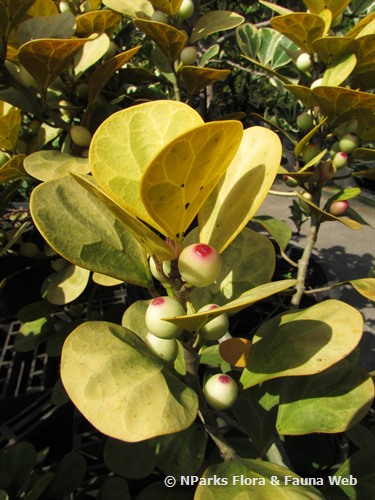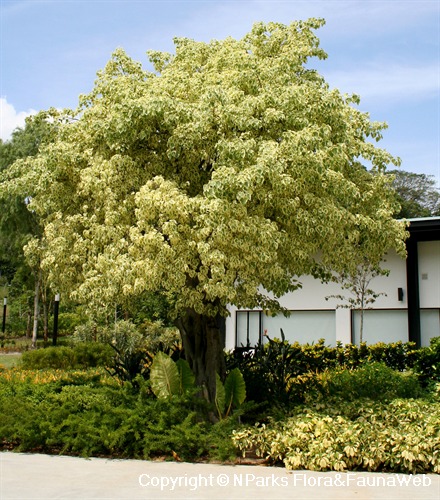_lowres.jpg)
Back
Ficus kochummeniana C.C.Berg
| Family Name: | Moraceae |
| Synonyms: | Ficus retusa var. borneensis Corner |
Growing to 30 m tall, Ficus kochummeniana is a strangler fig tree with dark brown hairs on the underside of the leaves. At maturity, the round figs turn orange to red, and are subtended by persistent dark brown bracts.
Name
Classifications and Characteristics
| Plant Division | Angiosperms (Flowering Seed Plants) |
|---|---|
| Plant Growth Form | Tree |
| Lifespan (in Singapore) | Perennial |
| Mode of Nutrition | Autotrophic |
| Maximum Height | 30 m |
Biogeography
| Native Distribution | Thailand, Peninsular Malaysia, Sumatra and Borneo. |
|---|---|
| Native Habitat | Terrestrial |
| Preferred Climate Zone | Tropical |
| Local Conservation Status | Native to Singapore (Critically Endangered (CR)) |
Description and Ethnobotany
| Growth Form | It is a strangler fig, up to 30 m tall. When injured, the plant exudates white sticky latex. |
|---|---|
| Foliage | Spirally arranged on the branches, the leaves are leathery and egg-shaped to oblong (4 – 18 cm long and 1.5 – 7.5 cm wide). Each leaf has 6 – 8 pairs of lateral veins. The pair of lateral veins near the leaf base is distinct and up to 1/3 – 1/2 (– 2/3) the length of the leaf blade. The tertiary venation is prominent and net-like. Waxy glands are present at the base of the midrib. The underside of the leaf is covered densely with very short soft hairs on the midrib while the lateral veins are covered with dark brown flattened hairs. The leaf tip is pointed (acuminate) to rounded while the leaf base is cuneate to obtuse. The petiole is 0.5 – 2.5 cm long and covered densely with very short soft hairs. The stipules are 1 – 2.5 cm long, hairy and may be sub-persistent or falling off early. |
| Flowers | The plant is dioecious with each plant bearing male or female flowers. The flowers are tiny and develop within the syconium (fig). |
| Fruit | The figs are sessile and occur at the axis in clusters of 1 – 2. Each fig has 3 bracts present at the base. These bracts are 0.3 – 0.5 cm long, covered with dark brown hairs and persistent. The figs are almost round and slightly flattened at the tip. At maturity, they turn orange to red. The ostiole is circular (0.25 – 0.3 cm diameter) and surrounded by a rim. The ostiole is closed by overlapping bracts where only the highly specialized pollinators can enter. The ovary is reddish to whitish. |
| Habitat | It grows in lowland peat swamp forest. |
| Similar | The leaf tip, venation, petiole and stipules are key features that set Ficus kochummeniana apart from Ficus retusa. F. kochummeniana has pointed to rounded leaf tip, 6 – 8 pairs of lateral veins, 0.5 – 2.5 cm long petiole and sub-persistent to caducous stipules. On the other hand, F. retusa has rounded leaf tip, 3 – 6 pairs of lateral veins, 0.5 – 1 cm long petiole and stipules that falls out early. |
| Associated Fauna | It is pollinated by fig wasps. Fruits are eaten and dispersed by birds and small mammals. |
| Etymology | The genus Ficus, in Latin, refers to the commercial edible fig (Ficus carica). The specific epithet honors K.M. Kochummen (1931 – 1999), a Malaysian botanist, who has contributed significantly to the botanical knowledge of the region. |
Fauna, Pollination and Dispersal
| Pollination Method(s) | Biotic (Fauna) |
|---|---|
| Seed or Spore Dispersal | Biotic (Fauna) |
Plant Care and Propagation
| Light Preference | Full Sun |
|---|---|
| Water Preference | Moderate Water |
| Plant Growth Rate | Moderate |
| Rootzone Tolerance | Well-Drained Soils, Waterlogged Soils |
Foliar
| Mature Foliage Colour(s) | Green |
|---|
References
| References | Berg, C.C. (2004). Flora Malesiana precursor for the treatment of Moraceae 7: Ficus subgenus Urostigma. Blumea 49: 463–480. Berg, C.C., and Corner, E.J.H. (2005). Moraceae: Ficeae. In Nooteboom, H.P. (ed) Flora Malesiana, Ser. 1, Vol. 17 Part 2, pp. vi – 730. Leiden: Nationaal Herbarium Nederland. Berg, C.C., Pattharahirantricin, N., and Chantarasuwan, B. (2011). Moraceae. In Santisuk, T. & Larsen, K. (eds.) Flora of Thailand 10(4): 469-675. The Forest Herbarium, Royal Forest Department. |
|---|
Image Repository
Others
| Master ID | 33589 |
|---|---|
| Species ID | 8003 |
| Flora Disclaimer | The information in this website has been compiled from reliable sources, such as reference works on medicinal plants. It is not a substitute for medical advice or treatment and NParks does not purport to provide any medical advice. Readers should always consult his/her physician before using or consuming a plant for medicinal purposes. |

_lowres.jpg)
_lowres.jpg)
_lowres.jpg)
_lowres.jpg)



